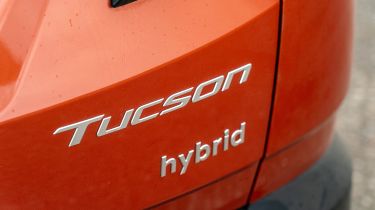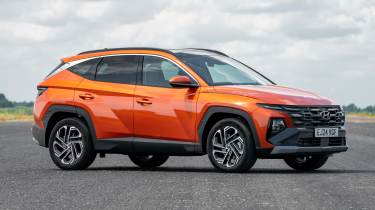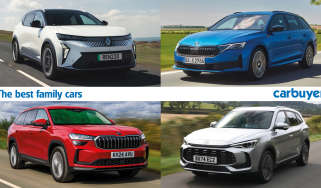Hyundai Tucson review - MPG, running costs & CO2
The focus shifts away from diesel and towards petrol hybrids, which offer great fuel economy
This time around Hyundai has forgone diesel power for the latest version of the Tucson, leaving just one 1.6-litre petrol engine with or without a varying degree of hybrid technology. There’s no fully-electric version of the Hyundai Tucson, with those bases covered by the brand’s other cars the Hyundai Kona Electric and Hyundai Ioniq 5.
Hyundai Tucson MPG & CO2
The range begins with a turbocharged 1.6-litre engine and manual transmission that can return up to 41.5mpg on the combined cycle with CO2 emissions of 154g/km, but the automatic version of this same engine gets mild-hybrid tech that makes it even more efficient, returning up to 44.8mpg with 142g/km CO2 emissions. These two options are front-wheel drive as standard, but specifying the mild-hybrid with four-wheel drive drops economy down to an official figure of 40.3mpg and CO2 emissions of 158g/km combined.
The Tucson Hybrid’s official economy figure of 49.5mpg isn’t drastically more frugal than the mild hybrid’s, but it’s worth considering that it comes with an extra bump up in power in comparison, so it manages a better blend of performance and fuel economy. CO2 emissions are also lower at 129g/km. This model also gets the option of four-wheel drive, which decreases economy to just 42.8mpg on the combined cycle, with CO2 emissions of 149g/km. When we put the Tucson Hybrid head-to-head with the hybrid versions of the Ford Kuga and Vauxhall Grandland in mid-2024, the Tucson managed 42.6mpg, putting it a few mpg behind its rivals.
More reviews
The Hyundai Tucson Plug-in Hybrid boasts the most impressive on-paper figures, being capable of up to 201.8mpg and CO2 emissions of just 29g/km. Take these stats with a pinch of salt, though, because the reality is that you won’t come close to that unless you keep your Tucson PHEV charged up for the majority of the time, so it might only make sense if you have or can install a home wallbox charger.
On a charge, the Tucson PHEV will travel for up to 38 miles, and it takes about two hours to fully recharge the 13.8kWh battery with a home wallbox charger capable of 7.2kW charging speeds. Those figures are some way behind the Volkswagen Tiguan eHybrid, though, which can travel up to 77 miles on a charge thanks to a larger 25.7kWh battery.
The plug-in hybrid Tucson will be the best choice for company car buyers because its low CO2 emissions put it in a low BiK (Benefit-in-Kind) band.
Insurance groups
Insurance groups for the latest Tucson start from group 18 for the entry-level petrol model in Advance trim. The mild-hybrid automatic sits two groups higher in 20 and the full-hybrid starts from group 21, while it’s not much more to insure the most powerful plug-in hybrid in group 23. Overall that makes the Tucson cheaper to insure than the Volkswagen Tiguan.
Warranty
While it may not match the seven-year/100,000-mile warranty of Kia, Hyundai's five-year and unlimited-mileage warranty isn't to be sniffed at. This is one of the most generous standard warranties in the business, beating rival offerings from Ford, SEAT, Vauxhall and Volkswagen hands down.
Servicing
Buyers can choose a 'Hyundai Sense' fixed-price servicing scheme, with either a fixed price upfront payment or monthly charge covering all maintenance. This way there should be no surprise bills, and prices during the period of cover won't go up with inflation.
Which Is Best?
Cheapest
- Name1.6T Advance 5dr
- Gearbox typeManual
- RRP£32,400
Most Economical
- Name1.6T Plug-in Hybrid Advance 5dr Auto
- Gearbox typeSemi-auto
- RRP£39,300
Fastest
- Name1.6T Plug-in Hybrid N Line 5dr Auto
- Gearbox typeSemi-auto
- RRP£41,800











